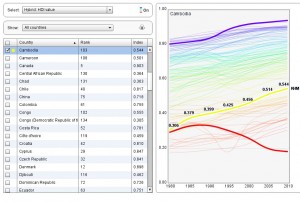The Mirror, Vol. 14, No. 690
On 4 November 2010, the UN Development Program published their Human Development Report 2010. For its 20th anniversary, it is not only focusing on the data for the present year, but it looks back over the past to reveal long time trends, as the introduction to the report says:
The Real Wealth of Nations: Pathways to Human Development
For the first time, the Report looks back rigorously at the past several decades and identifies often surprising trends and patterns with important lessons for the future. These varied pathways to human development show that there is no single formula for sustainable progress — and that impressive gains can be achieved even without consistent economic growth.
The UNDP website with this year’s report is very rich in data, and it is technically designed so that these can be looked at under different aspects easily; accessing the related UNDP website allows to study many more facets in addition to the Human Development Index Trends. There are statistics on many countries on a map of the world, and it is even possible to create unique country comparisons and rankings, and, of course, data for individual countries can be downloaded.
The UNDP Human Development Index is calculated on the basis of the original indicators for health, education and income data of a country.
Note: When you click with the mouse on the picture, you get a better graphic quality.
Here is a view over past developments, showing three lines: on top in the Asia-Pacific region is Australia [blue] (Norway is on top of the world list), at the bottom is Zimbabwe [red] – and in the middle I highlight the Cambodia line [yellow]. The figure and the numbers show a very high rate of improvement (the reference figure is the value of 1). Cambodia was the country with the fastest growth rate in Asia. But it is necessary to consider the nature of these data presented on this picture: it shows growth over time – it does not say anything about the present actual values related to these three countries.
Apart from the Human Development Index, a number of other indices are published, some of them annually:
- The Global Competitiveness Report
- The Global Manufacturing Competitiveness Index
- The Corruption Perception Index
- The Index of Economic Freedom
- The Press Freedom Index
- The Corporate Social Responsibility Index (related to industries, not countries)
- The Global Hunger Index
- The World Health Statistics
Readers who did follow, in the past, the reactions to the rankings of Cambodia in such and similar indices will remember that Cambodian government representatives – in country, or by Cambodian embassies abroad – have often criticized the data published as “biased” against Cambodia or simply as “wrong.” It has to be noted, however, that such indices are not the result of some individuals assembling a country image – they are based on data collected according to publicly available selection lists, and the same data are collected for all country covered according to the same procedures. The position of a country is then what the mathematical process of analyzing these data calculates. It is an objective picture – based on the data. For any valid criticism, it would be necessary to criticize the assortment of data collected, or to indicate whether there were made any mistakes in collecting the data. The Cambodia Daily reports from the present 2010 UN Human Development Index:
When Cambodia’s score was adjusted for levels of inequality in the distribution of health, education and income among its citizens, it lost 28 percent of its development index score, according to the report, somewhat more than the East Asian regional average of 21.2 percent.
And the spokesperson of the Council of Ministers is quoted to have made the following comment:
Council of Ministers’ spokesman Phay Siphan said the government had its own indicators for defining development progress and that he could offer little comment on Cambodia’s development ranking.
It would be interesting to know which different indicators the Cambodian government is using for its definition of the development progress, different from the UNDP Human Development Index findings.
Have a look at the last editorial – you can access it directly from the main page of the Mirror.
And please recommend The Mirror also to your colleagues and friends.


Recent Comments